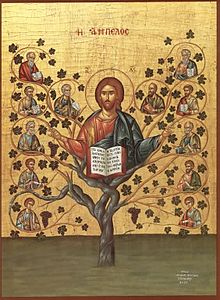True Vine

The True Vine (Greek: ἡ ἄμπελος ἡ ἀληθινή hē ampelos hē alēthinē) is an allegory or parable given by Jesus in the New Testament. Found in John 15:1–17, it describes Jesus' disciples as branches of himself, who is described as the "true vine", and God the Father the "husbandman".
Old Testament

There are numerous

Ezek 17:5–10 contains vine imagery which refers to a king of the house of David, Zedekiah, who was set up as king in Judah by Nebuchadnezzar.[2] Christians link the theme to the Tree of life and the Tree of Jesse. The Tree of Jesse originates in a passage in the biblical Book of Isaiah. The book metaphorically describes the Tree of Jesse in a passage and references the descent of the Messiah and is accepted by Christians as referring to Jesus. The various figures depicted in the lineage of Jesus are drawn from those names listed in the Gospel of Matthew and the Gospel of Luke. Sometimes the Virgin Mary is also depicted in a vine.[3]
Cretan School

The True Vine was a popular theme painted by Cretan artists. One of the earliest painters of the theme was
Interpretation as parable

Several authors such as Barbara Reid, Arland Hultgren or Donald Griggs comment that "parables are noticeably absent from the Gospel of John".[9][10][11] According to the Catholic Encyclopedia, "There are no parables in St. John's Gospel";[12] and according to the Encyclopædia Britannica, "Here Jesus' teaching contains no parables and but three allegories, the Synoptists present it as parabolic through and through."[13] These sources all suggest that the passage is better described as a metaphor than a parable. Some writers, however, notably John Calvin,[14] referred to the passage by a Latin term that is typically translated into English as a "parable".
Text
John 15:1–17 reads in the
See also
- Christifideles laici
- I am (biblical term)
- Fruit of the Holy Spirit
- The Tree and its Fruits
- Gufna, heavenly grapevine in Mandaeism
Notes
- ISBN 1573122785.
- ^ "Intro to Ezekiel". Biblica. 2016-10-09. Retrieved 2019-11-06.
- ^ Bladen 2021, pp. 20–50.
- ^ Fafalis Giorgos (June 15, 2022). "Christ the Vine". National Documentation Centre. Archived from the original on April 19, 2024. Retrieved April 19, 2024.
- ^ Staff Writers (December 5, 2021). "Greek Art Catalogue". The Benaki Museum. Archived from the original on December 6, 2021. Retrieved April 19, 2024.
- ISBN 9789602149119.
- ISBN 960-7916-00-X.
- ^ Bladen 2021, p. 51.
- ISBN 0-8146-2550-9page 3
- ISBN 0-8028-6077-Xpage 2
- ISBN 0-664-22577-2page 52
- ^
 Barry, William (1913). "Parables". In Herbermann, Charles (ed.). Catholic Encyclopedia. New York: Robert Appleton Company. Retrieved 5 July 2016.
Barry, William (1913). "Parables". In Herbermann, Charles (ed.). Catholic Encyclopedia. New York: Robert Appleton Company. Retrieved 5 July 2016.
- ^ von Hügel, Friedrich (1911). . In Chisholm, Hugh (ed.). Encyclopædia Britannica. Vol. 15 (11th ed.). Cambridge University Press. p. 454.
- ^ Calvin, John (1553). Commentary on the Gospel According to John. Vol. 2. Translated by William Pringle. Retrieved 5 July 2016.
- ^ John 15:1–17
Bibliography
- Bladen, Victoria (2021). The Tree of Life and Arboreal Aesthetics in Early Modern Literature. New York, NY: Taylor & Francis. ISBN 9781000454819.
